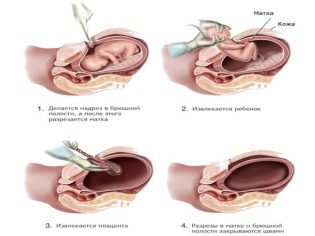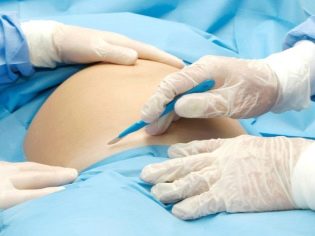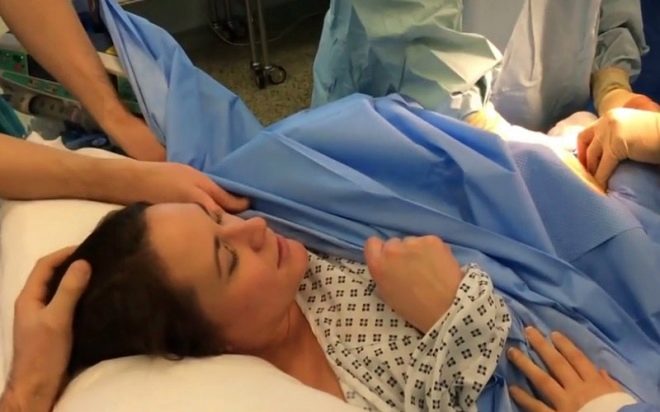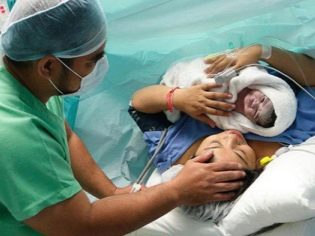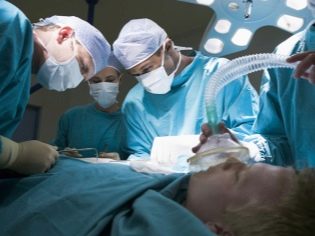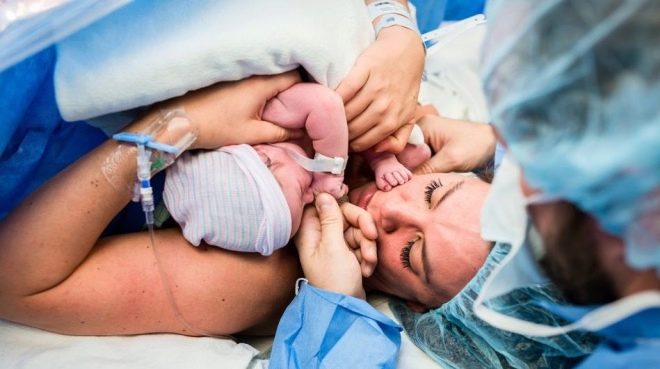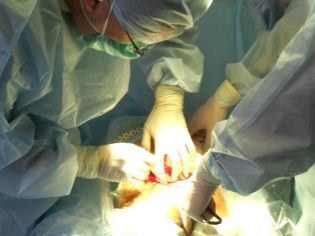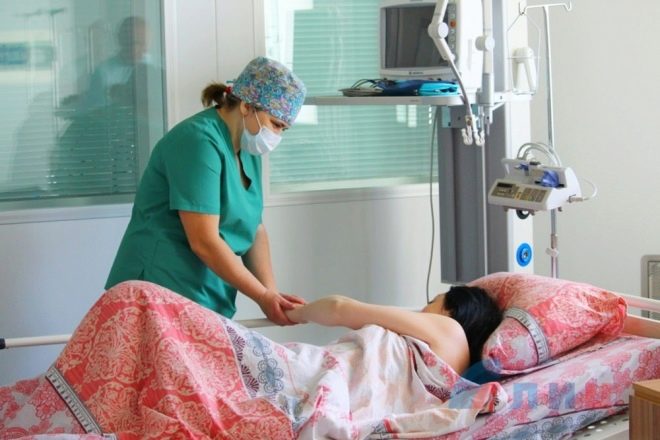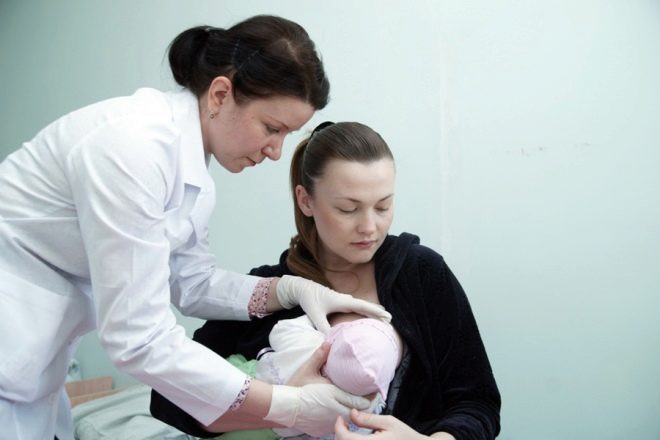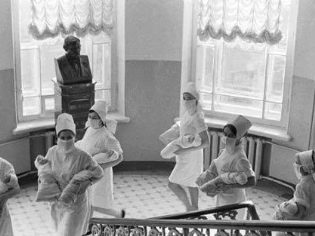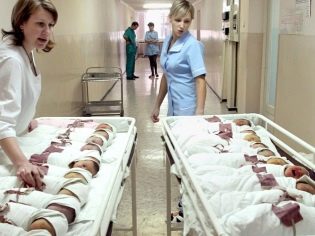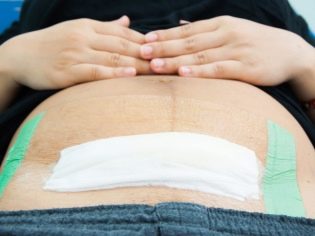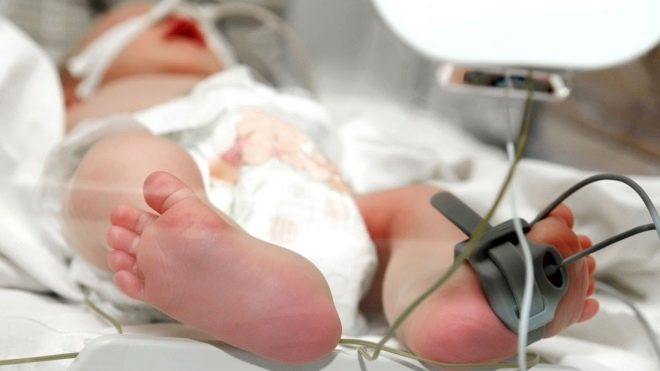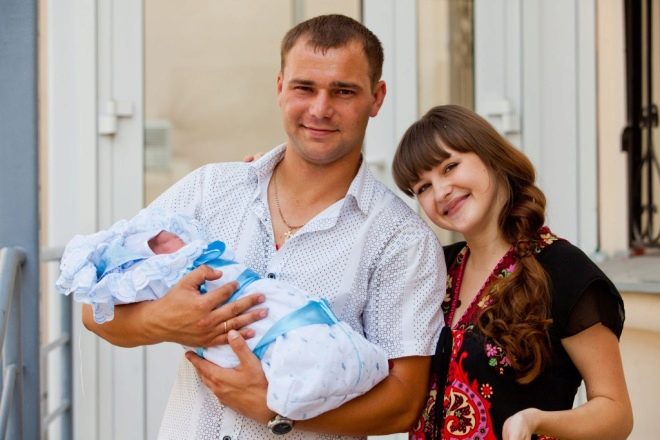On which day is usually discharged after a cesarean section from the hospital?
Caesarean section requires a longer recovery after childbirth. The operation is serious, abdominal, and therefore the rehabilitation process after it proceeds completely differently than after natural childbirth.
In this article we will tell you how much time a woman will have to stay in the hospital after the operation, on what day mother and baby are usually discharged from the hospital after cesarean, and what can affect these periods.
How is it done?
In natural childbirth, the baby leaves the womb through the genital tract. This is a long and laborious process, largely regulated not by doctors, not a woman in labor, but by Mother Nature. For mother and child, birth is long and difficult, but the recovery process is also more natural, physiological.
A cesarean section is done when natural childbirth for certain reasons is not possible or can be very dangerous for the life and health of a woman and her baby. In this case, the child is removed not through the genital tract, but through an incision made by the surgeon in the uterus and the anterior abdominal wall.
The reasons for which a woman is recommended surgery may be different. Some become apparent even during the period of childbearing, and then a planned caesarean is appointed, others appear suddenly already in the process of childbirth, and then an emergency operation is performed.
For a planned surgical delivery, the most common causes are:
- large fetal size;
- discrepancy between the size of the pelvis and the size of the fetus;
- pronounced high or low water;
- placenta previa with overlapping internal os;
- neoplastic tumors in the uterus;
- postoperative uterine scars;
- pelvic or transverse position of the fetus by the end of pregnancy;
- genital infections in women;
- preeclampsia;
- heart disease and blood vessels in women, renal failure, myopia and retinal detachment in history.
For emergency surgery, the readings are completely different. Most often, the need for the completion of labor after surgery arises when primary or secondary weakness develops.
Weak contractions that do not lead to the opening of the cervix to the desired size, stopped attempts, a long anhydrous period, lack of effect from drug stimulation, signs of fetal hypoxia, massive bleeding from the mother - all this is the reason for transferring the woman from the delivery room to the operating room.
If an operation is planned, the woman will go to the hospital in advance, not waiting for the contractions to begin or the water to drain.
Most often, hospitalization is prescribed at 38-39 weeks of pregnancy, and if the operation is not performed for the first time, then about a week earlier.
For several days, a woman is examined, tests are done, a control ultrasound is performed, anesthesia is chosen - an epidural (spinal) anesthesia, in which the woman will be conscious throughout the operation or general anesthesia, in which the woman will have a good sleep with medication.
On the day of surgery in the morning, a woman is given an enema, shaving the pubis, and measuring pressure and body temperature. In the operating room is delivered on a gurney and anesthesia is performed first. After the anesthesia is injected, the doctors mark out the incision lines, treat the abdomen and perineum with an alcohol solution or iodine solution and proceed with the operation.
It lasts from 20 to 40 minutes. During this time, the surgeon cuts the abdominal wall, takes aside the muscles and bladder. If the operation is planned, the incision is made horizontal, in the lower segment of the uterus. Then they make an incision in the uterus, perforate the fetal bladder, drain the amniotic fluid and take out the baby. The moment of birth of the baby to the light, a woman can hear his first cry only if she chooses epidural anesthesia. In a state of general anesthesia, these moments of the woman in labor cannot be survived.
The baby is passed to a neonatologist or a nurse in the pediatric ward. While the crumbs are treated with the umbilical cord, weighed and evaluated on the Apgar scale, the surgeon manually separates the placenta from the uterine wall and sutures the reproductive organ. Then the muscles and the bladder are replaced and the external sutures are applied.
If the operation is an emergency, the incision may be vertical, but it is resorted to only when there is a vital need to remove the child as soon as possible because of the risk of his death in the womb.
With repeated deliveries by a COP, the operation can last longer than during the first operation, it is associated with the necessary time spent on excision of the old scar, which is necessarily carried out, because every time a woman is operated strictly on the old scar.
Rehabilitation
From the operating room, the woman is transferred to the intensive care unit, and the baby is transferred to the children's ward. A few hours for the newly-made mother to be spent in intensive care under the constant supervision of physicians. They will monitor the level of blood pressure, body temperature, heart rate. All this is very important for assessing the condition of a woman, for assessing the quality of her exit from the state of anesthesia, whatever it is.
Sometimes prescribed drip of saline with the addition of vitamins. But recently, doctors are increasingly refusing intravenous fluids if there is no heavy bleeding, so as not to cause edema in the woman. Already from the first hours of the young mommy inject reducing drugs and painkillers. The uterus with the scar is reduced much slower and worse than the uterus of a woman who gave birth naturally, so you can not do without appropriate medicines.
After about five hours, the woman, if she feels well, is transported to the postpartum ward, where she will have to spend the rest of the time before discharge from the hospital.
After about 6-8 hours, doctors strongly recommend that you begin to be active. This will be the best prevention of inflammation, infection, stagnation and adhesions.
They try to attach the baby to the breast as early as possible in order to speed up the process of contraction of the uterine muscles and stimulate lactation, which after the operation can be established at a slower pace.
A joint stay with the baby is usually allowed on the second day, provided that the woman gets up, starts walking, that she can take care of the crumbs on her own.
In order to recover faster, it is recommended to start moving, but do it in stages.
First, master the turns from the back to the right and left side with the support of the seam area with your hand. Then learn to confidently lie on your side. Lying on the side, you can feed the baby to avoid unnecessary weight lifting, which is absolutely contraindicated after surgery.
After that, a woman can lower her legs and sit down. It is better to get up and walk after the surgery, with support or support on the bed or wall, since dizziness will accompany the newly made mother for at least another few days.
When do they write out?
Even 15-20 years ago, after a cesarean section, a woman could get home under the most favorable circumstances only for 10 days.
At 7-8 days after surgical delivery, she was removed by stitches, she was given a control ultrasound, she was watched for a couple of days and she was allowed to leave for home.Antibiotics were usually given for 10 days in order to rule out the possibility of infection even theoretically.
In recent years, in maternity hospitals a completely different approach to cesarean section and rehabilitation issues after it. Antibiotics are now prescribed only to women who have signs of early inflammation; the rest are not treated with antibiotic therapy, limited to administering painkillers and reducing drugs (oxytocin) for the first three to four days after surgery.
This approach forced the review and timing of discharge. Keeping a woman in the hospital for 10 days is no longer necessary. After a cesarean section, they are now discharged on the fifth day, and after natural birth, on the third.
A woman can get home with a baby in five days only if there are no complications.
The seams on the fifth day, of course, do not remove. That is, Mom is discharged home with external seams.
Internal dissolve themselves. The external ones will have to be removed, but already at the antenatal clinic at the place of residence at 7-8 days after the operation, it is sometimes recommended to remove the stitches not earlier than 9-10 days. An individual recommendation on the timing is usually given by the doctor in the maternity hospital before discharge.
Reasons for changing the timing
What factors may affect the duration of stay in the maternity hospital? We will say right away, ahead of the questions of the most impatient that it will not be possible to leave the hospital before the fifth day. No doctor, in any clinic or maternity hospital in Russia, will take responsibility for the possible death of a woman or baby.
Five days is the minimum time for observing them, and therefore you can not even try to persuade the attending physician to let go home early.
A woman who has signs of an inflammatory process can be detained in the maternity hospital - body temperature is elevated, pressure is jumping, episodes of breakthrough bleeding from the genitals are observed.
According to the results of an ultrasound scan, it may appear that the uterus has not been well reduced or fragments of the placenta have remained in it (which happens very rarely). In this case, the woman in labor is delayed by at least another 2-4 days. Then there may be two options - either she will be discharged home or transferred to a gynecological hospital for further treatment. The child will be sent home with his father and close relatives.
The second reason for the doctor’s refusal to be discharged on the fifth day is the health problems of the baby. They can be very different.
In the first 3-4 days of life, the baby is carefully examined, various tests are taken from him, and functional tests are carried out. When a child’s pathology is found, they can be left in the maternity hospital for a few more days, after which he will either be sent home with his mother, or both will be transferred to the children's hospital in the early childhood department for subsequent treatment. Transportation is carried out by special medical transport.
Useful tips
The extract after a cesarean section has several features that a woman needs to know in advance and warn her loved ones. Our tips will help you check out with the greatest comfort and safety.
- A woman is absolutely not allowed to hold the baby in her arms; weight lifting is over 3 kilograms. - the strictest ban for the next six months. Especially carefully you need to adhere to this rule in the first days and weeks after surgery. Therefore, any of the relatives, but not the newly-made mother, can pose in her arms with the baby on a solemn discharge.
- Ask relatives to bring you to the hospital for discharge of the dress. Best free. Trousers, jeans, breeches and other belt clothing will bring a lot of inconvenience, because the seams have not yet been removed, and pressure on the seam area of the zippers and buttons should be completely excluded for at least 3 weeks until the outer seam heals completely.A tight dress will not look too aesthetically pleasing, because even in thin women, after a caesarean section, the stomach sags and retracts much longer than the tummy after natural childbirth.
- Ask family or friends to take care of a separate back seat in the car in advance.on which the woman will go home. It is quite difficult to sit after the surgery for a long time - it pulls the stitches, the backache hurts, it may be necessary for the woman to lie down or take a half-sitting position. If in the car on the seat, besides her, there will be a couple more people, the newly made mother cannot do it physically. The child on the way home must be held by another adult.
- It is better to refuse from the table in honor of the discharge and collect relatives in 2-3 weeks, since the woman is shown peace, besides strangers can be a source of infection.
A well-known pediatrician Yevgeny Komarovsky presents his view on cesarean section in the next video.


